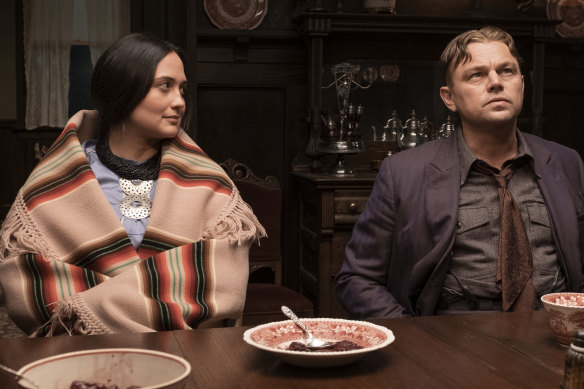By Anwen Crawford
KILLERS OF THE FLOWER MOON ★★★½
(M) 206 minutes
The camera lifts above a car being driven on a dirt road, early in Martin Scorsese’s Killers of the Flower Moon. It keeps on lifting until all we can see to the horizon is green fields pocked with oil derricks. Not even Scorsese can resist the temptation of a drone shot, but this opening flourish is stylistically deceptive. Billed as an epic, Killers of the Flower Moon is a claustrophobic film, mostly set indoors. The violence it depicts is intimate yet comprehensive: genocide as implemented in one town, against one community.

Lily Gladstone as Mollie and Leonardo DiCaprio as Ernest in Killers of the Flower Moon.
The town is Fairfax, in Osage County, Oklahoma, during the early 1920s. The community is the Osage Nation, displaced from their original lands but holding mineral rights over their Oklahoma reservation. Each oil derrick is a cash stream, and the two white men driving in are as thirsty for that cash as bison bent over a waterhole. “I just love money,” grins Ernest Burkhart (Leonardo DiCaprio), a returned army cook who would be purposeless and broke if not for his uncle William King Hale (Robert De Niro), a local grandee. Ernest has hardly been in Fairfax a day when Hale, self-declared friend of the Osage, outlines a scheme for his nephew to marry an Osage woman, and murder her, in pursuit of her mineral rights.
Such murders really did take place. Scorsese and his co-writer Eric Roth, who based their screenplay on a prize-winning non-fiction book by journalist David Grann, achieve a queasy narrative propulsion as the killings of Osage people, and conspiracies to commit them, pile up.
Ernest takes a job as chauffeur, through which he meets the elegant and droll Mollie Brown (Lily Gladstone), who shares, with her mother and two sisters, the profit from an Osage oil licence. Mollie initially describes her would-be suitor as a “coyote”. She and her sisters, Minnie and Anna, make fun of the white men’s craving for wealth. But Ernest also teases Mollie, and the fact he can make her laugh is the first chink in her armour.
Grann’s book frames the Osage County murders in the context of the founding of the FBI, then under J. Edgar Hoover, with Jesse Plemons in a minor role as investigator Tom White. But this is not a police procedural, or a Western, or even a tragedy in the dramatic sense. Hale is too obvious an antagonist: his frequent grandiloquence about the nobility of the Osage is humbug. He doesn’t believe it.
But plenty of frontier colonialists did believe in their good intentions, and it might have been more honest and made for a more suspenseful film, had some aspect of that cruel-to-be-kind attitude been sincerely embodied by these characters. Ernest is a little more conflicted, but only late in DiCaprio’s performance, and never in De Niro’s, is there a sense of self-betrayal befitting tragedy, of somebody realising they have become their worst self, because of and not in spite of their intentions.
“Violent men do violent things” might stand as summary of Scorsese’s thematic obsessions. That much has been true for half a century. It is also true that, because of this, Scorsese’s moral sympathies have often been aligned with his female characters. It was the case in Raging Bull, where Cathy Moriarty played the indomitable teenage bride to De Niro’s self-deluded boxer Jake LaMotta, in what is arguably Scorsese’s masterwork.
It was the case in The Irishman, in which only Peggy Sheeran, played by Anna Paquin, finds the gumption to stand up to her hitman father Frank, played again by De Niro. And is true again here. Mollie’s sagacity, and Gladstone’s intelligence as an actor, make her character the moral centre of the film.
This may come as no surprise to anyone who saw Gladstone’s unforgettable performance in Kelly Reichardt’s study of contemporary small-town life Certain Women. Killers provides her with a bigger if not a better role, and of all the Scorsese women who have preceded her, Mollie’s clear-sightedness about her husband’s deceit reminds me most of May Welland in The Age of Innocence, played so evenly by Winona Ryder. Here, in her still self-assurance, which is tortuously undermined, Gladstone is ably supported by Cara Jade Myers as the vivacious and pugnacious Anna, and by Tantoo Cardinal as their watchful mother, Lizzie Q.
The flaws in this ambitious, intermittently powerful film are nearly redeemed by a very late scene in which Scorsese throws open the question of how and why “true crime” endures as a genre. Whose appetite does it serve, and who does it disregard in the name of entertainment? The curtain call implicates us all, and as a gesture of self-critique near the end of a storied director’s career, it is also a moment of filmmaking brilliance.
Killers of the Flower Moon is released in cinemas on October 19.
Find out the next TV, streaming series and movies to add to your must-sees. Get The Watchlist delivered every Thursday.